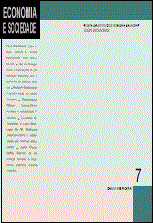Resumo
Este artigo enfoca acontecimentos recentes, relacionados à moeda e ao sistema bancário, que dominaram o nosso contexto econômico. Uma premissa básica da análise apresentada é a de que as modalidades específicas de regulação monetária são decisivas para moldar o padrão de crescimento das economias capitalistas avançadas. Temos testemunhado uma transformação na natureza do capital financeiro, cujas principais características representam o tema central deste artigo. Os efeitos cumulativos, derivados de tal acontecimento, ameaçam a estabilidade do nosso sistema econômico e, portanto, precisam ser redirecionados por políticas coordenadas.
Abstract
This paper focuses on recent developments concerning money and banking, have come to dominate our socio economic context. A basic premise of the analysis presented here is that the precise modalities of money's regulation play a decisive role in shaping the growth pattern of advanced capitalist economies. We have witnessed a transformation in the nature of financial capital, whose principal features form the central focus of our paper. The cumulative effects of these developments threaten the stability of our economic system, and therefore need to be redirected by coordinated police action.
Key-words: Money, Banks, Finance – United States. Monetary policy. Monetary reform
Referências
AGLIETTA, M. Régulation et crises du capitalisme. Paris: Calmann-Levy, 1976.
________. Le risque de systeme. Revue d’Economie Financière, v.17, n.3, 1991.
________; Orlean, A. La violence de la monnaie. Paris: PUF, 1982.
BASLE, M.; MAZIER, J.; VIDAL, J.F. Quand les crises durent... Paris: Economica, 1993.
BOWLES, S.; GORDON, D.; WEISSKOPF, T. Beyond the waste land. New York: Doubleday, 1983.
BOYER, R. La théorie de la régulation: une analyse critique. Paris: La Découverte, 1986.
________; MISTRAL, J. Accumulation, inflation, crises. Paris: PUF, 1978.
CARLSON, J. Assessing real interest rates. Federal Reserve Bank of Cleveland Economic Commentary, Oct. 1993.
CARLSON, K. The U.S. balance sheet: what is it and what does it tell us. Federal Reserve Bank of St. Louis Review, v.73, n.5, p.13, 1991.
CHESNAIS, F. La globalisation du capital. Paris: Syros, 1994.
________. Graves secousses dans le systeme financier mondial. Le Monde Diplomatique, Mai 1995.
CORRIGAN, G. Financial market structure: a longer view. New York: Federal Reserve Bank of New York, 1987a.
________. A perspective on the globalization of financial markets and institutions. Federal Reserve Bank of New York Quarterly Review, Spring 1987b.
COVER story: the future of money. Business Week, Jun. 12, 1995 DARIN, R.; HETZEL, R. An empirical measure of the real rate of interest. Federal Reserve Bank of Richmond Economic Quarterly, Winter 1995.
DAVIDSON, P. A post keynesian view of theories and causes for high real interest rates. Themes Papers in Political Economy, London, 1986.
DE BRUNHOFF, S. État et capital. Grenoble: PUG/Maspero, 1976.
________. Les rapports d’argent. Grenoble: PUG, 1979.
________. Fictitious capital. In: EATWELL, J.; MILGATE, M.; NEWMAN, P., ed. The new Palgrave: marxian economics. London: Macmillan, 1990.
GUTTMANN, R. Stagflation and credit-money in the USA. British Review of Economic Issues, v.6, n.15, 1984.
________. Crisis and reform of the international monetary system. In: ARESTIS, P., ed. Post keynesian monetary economics. Aldershot, UK: Edward Elgar, 1988.
________. Reforming money and finance: institutions and markets in flux. Armonk, NY: M.E. Sharpe, 1989.
________. The regime of credit-money and its current transition. Economies et Societés, v.24, n.6, 1990.
________. How credit money shapes the economy: the United States in a global system. Armonk, NY: M.E. Sharpe, 1994.
________. Monnaie et crédit dans la théorie de la régulation. In: BOYER, R.; SAILLARD, Y., ed. Théorie de la régulation: l’état des savoirs. Paris: La Découverte, 1995.
HAYEK, F. Profits, interest and investment. London: Routledge, 1939.
HILFERDING, R. Finance capital. London: Routledge and Kegan Paul, 1985. (First published in German in 1910).
KAUTMAN, G.; MOTE, L. Is banking a declining industry? A historical perspective. Economic Perspective, May/Jun. 1994.
KEYNES, J.M. The general theory of employment, interest and money. London: Macmillan, 1936.
________. Proposal for an International Clearing Union. Cmnd 6437. London: Royal Economic Society, 1980. (Reprinted in The Collected writings of John Maynard Keynes, v.26).
KONDRATIEFF, N. Die langen Wellen der Konjunktur. Archiv für Sozialwissenschaft und Sozialpolitik, v.56, n.3, 1926.
LIPIETZ, A. Crise et inflation, pourquoi? Paris: Maspero, 1979.
________. Le monde enchanté. Paris: Maspero, 1983.
MARX, K. Das Kapital. Hamburg: Meissner, 1867. v.1.
________. Das Kapital. Hamburg: Meissner, 1894. v.3.
MINSKY, H. Can ‘it’ happen again? Armonk, NY: M.E. Sharpe, 1982.
OSLER, C.L. High foreign real interest rates and investment in the 1990s. Federal Reserve Bank of New York Quarterly Review, Spring 1994.
PLIHON, D. Les taux de change. Paris: La Découverte, 1991.
POLANYI, K. The great transformation. Boston: Beacon Press, 1944.
SCHUMPETER, J. History of economic analysis. London: Allen and Unwin, 1954.
WOLFF, E. Top heavy: a study of the increasing inequality of wealth in America. New York: Twentieth Century Fund Press, 1995.
WOLFSON, M. Financial crises: the postwar U.S. experience. 2nd.ed. Armonk, NY: M.E. Sharpe, 1993.
A Economia e Sociedade utiliza a licença do Creative Commons (CC), preservando assim, a integridade dos artigos em ambiente de acesso aberto.

